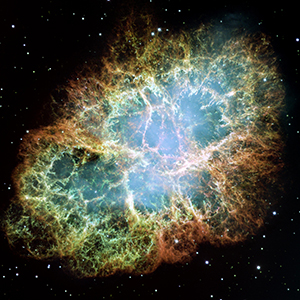Telescope will investigate mysterious Crab pulsar
In the coming days, a telescope designed and built at KTH will be launched into the stratosphere to observe the small pulsar at the centre of the spectacular Crab Nebula. Carried aloft by a 150-diametre helium balloon about 40km above Earth, the telescope will by used by researchers at KTH to determine the polarisation of radiation waves emitted by the Crab pulsar, says Physics Professor Mark Pearce, the project leader at KTH Royal Institute of Technology.
"This particular pulsar rotates on an axis 30 times per second, producing flashes of X-rays on the sky like a cosmic lighthouse," Pearce says.
Barely 15 km in diametre but with a mass equal to our solar system's Sun (which by comparison has a diametre of 1.4 million km), the Crab pulsar is a rotating neutron star, a kind of ultra-dense zombie sun that forms when a star exhausts its fuel and collapses upon itself due to the force of its own gravity. If they were any denser, they'd be black holes.
The Crab Nebula itself is only about 1,000 years old and is one of the most studied objects in the heavens. But examining the polarisation of the pulsar's X-rays — that is, plane in which the radiation waves oscillate — is new territory.
"Such measurements tell us about the environment in which the X-rays are produced," Pearce says. "We'd be able to collect information about the magnetic field configuration of the pulsar, which would be difficult to obtain with standard observation methods."
He adds that if conditions permit, the telescope will be used to observe the black hole, Cygnus X-1, which is about 6,000 light years from our Sun.
Pearce says the building of the PoGO+ (which stands for Polarised Gamma-ray Observer) telescope also involved Hiroshima University in Japan, and that the system which enables it to be pointed at objects in the sky was designed and built by DST Control in Linköping, Sweden. Swedish Space Corporation built the support systems, as well as the gondola in which the telescope is housed.
The launch window started on July 1, but poor weather conditions will keep PoGO+ grounded for most of the week at the Esrange Space Centre at Kiruna, Sweden.

At the centre of the Crab Nebula is a neutron star that rotates 30 times per second, emitting a single X ray beam like a cosmic lighthouse. (Image: NASA)
PoGO+ is actually the second generation of a telescope that was launched in 2013. "We have changed the design to give a more precise determination of the degree of polarisation of the Crab X-rays," he says.
"We have also aimed to improve the reliability of the telescope, since we had problems with the thermal environment in 2013. Flying at the top of the atmosphere, there is no convection to aid cooling and no atmosphere to absorb the sun's rays."
Although it will be flying high above the ground, the balloon — which is slightly bigger than the Globe Arena in Stockholm, Earth's largest hemispheric dome — could be visible to the naked eye providing the sun illumination angle is favourable.
The balloon is filled with 1.1 million cubic metres of helium gas. At the end of the flight, the balloon will be opened and the telescope will return to Earth by parachute.





